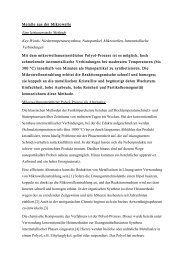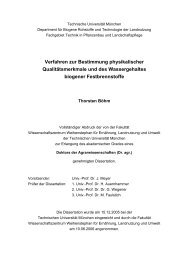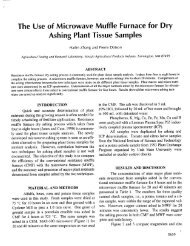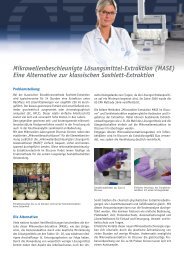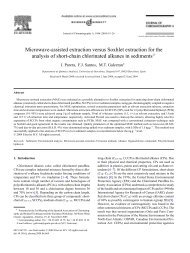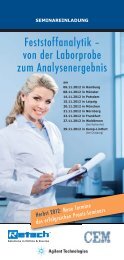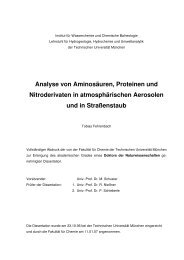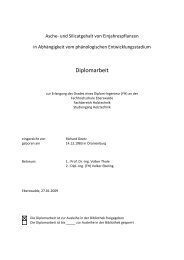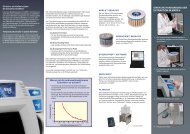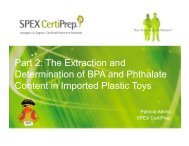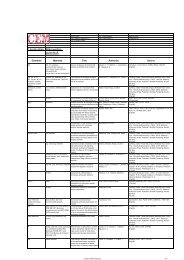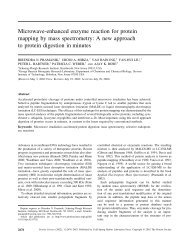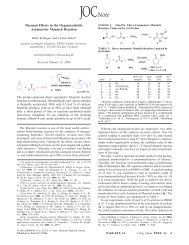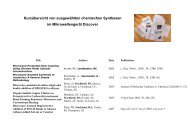Application Note BIO-0001 Microwave Synthesis of ACP 65-74
Application Note BIO-0001 Microwave Synthesis of ACP 65-74
Application Note BIO-0001 Microwave Synthesis of ACP 65-74
Create successful ePaper yourself
Turn your PDF publications into a flip-book with our unique Google optimized e-Paper software.
Page 1 <strong>of</strong> 2<br />
<strong>Microwave</strong> <strong>Synthesis</strong> <strong>of</strong> <strong>ACP</strong> <strong>65</strong>‐<strong>74</strong><br />
INTRODUCTION<br />
The application <strong>of</strong> microwave energy has<br />
proved to be a major enabling tool for many<br />
chemical reactions requiring energy input,<br />
and recently microwave irradiation has<br />
been applied to solid phase peptide<br />
synthesis. Peptide synthesis <strong>of</strong>ten suffers<br />
from long reaction times and low yields due<br />
to problems such as aggregation.<br />
<strong>Microwave</strong> energy can help break up these<br />
aggregates improving the synthesis quality<br />
while speeding up the synthesis rate. The<br />
acyl carrier protein (<strong>ACP</strong>) fragment <strong>65</strong>‐<strong>74</strong>,<br />
H‐Val‐Gln‐Ala‐Ala‐Ile‐Asp‐Tyr‐Ile‐Asn‐Gly‐<br />
OH, is a widely used standard model for<br />
demonstrating peptide synthesis efficiency.<br />
The presence <strong>of</strong> several hydrophobic<br />
residues, and in particular the hindered Val<br />
and Ile residues, can lead to poor coupling<br />
and deprotection reactions resulting in low<br />
yield and purity <strong>of</strong> the peptide.<br />
In this application note <strong>ACP</strong> <strong>65</strong>‐<strong>74</strong> is<br />
synthesized in good yield and purity using<br />
microwave irradiation for the deprotection,<br />
coupling, and final cleavage steps.<br />
MATERIALS AND METHODS<br />
Reagents<br />
All Fmoc amino acids were obtained from<br />
CEM Corporation and contained the<br />
following side chain protecting groups:<br />
Asn(Trt), Asp(OtBu), Gln(Trt), and Tyr(tBu).<br />
O‐(Benzotriazol‐1‐yl)‐N,N,N′,N′‐<br />
tetramethyluronium hexafluorophosphate<br />
(HBTU) and 1‐hydroxybenztriazole hydrate<br />
(HOBt) were also obtained from CEM<br />
Corporation. Fmoc‐Gly‐Wang resin was<br />
<strong>Application</strong> <strong>Note</strong> <strong>BIO</strong>‐<strong>0001</strong><br />
obtained from Novabiochem (San Diego,<br />
CA). Diisopropylethylamine (DIEA),<br />
piperidine, trifluoroacetic acid (TFA),<br />
triisopropylsilane (TIS), and 3,6‐dioxa‐1,8‐<br />
octanedithiol (DODT) were obtained from<br />
Sigma Aldrich (St. Louis, MO).<br />
Dichloromethane (DCM), N,N‐<br />
dimethylformamide (DMF), N‐<br />
methylpyrrolidine (NMP), anhydrous diethyl<br />
ether, acetic acid, HPLC grade water, and<br />
HPLC grade acetonitrile were obtained from<br />
VWR (West Chester, PA).<br />
Peptide <strong>Synthesis</strong><br />
The peptide was prepared using the CEM<br />
Liberty automated microwave peptide<br />
synthesizer on 0.164 g <strong>of</strong> Fmoc‐Gly‐Wang<br />
resin (0.61 meq/g substitution).<br />
Deprotection (20% piperidine with 0.1 M<br />
HOBt) was performed in two stages with an<br />
initial deprotection <strong>of</strong> 30 seconds followed<br />
by 3 minutes at 75 °C. Coupling reactions<br />
were performed with 5 fold excess Fmoc‐<br />
AA‐OH with 1:0.9:2 AA/HBTU/DIEA for 5<br />
minutes at 75 °C. Cleavage was performed<br />
using 92.5:2.5:2.5:2.5 TFA/water/TIS/DODT<br />
for 30 minutes at 38 °C. Following cleavage<br />
the peptide was precipitated and washed<br />
with diethyl ether.<br />
Peptide Analysis<br />
The peptide was analyzed on a Waters<br />
Atlantis C18 column (2.1 x 150 mm) at 214<br />
nm with a gradient <strong>of</strong> 5 – 95% MeCN (0.1%<br />
formic acid), 0 – 20 minutes. Mass analysis<br />
was performed using an LCQ Advantage ion<br />
trap mass spectrometer with electrospray<br />
ionization (Thermo Electron, Waltham, MA).
RESULTS AND DISCUSSION<br />
<strong>ACP</strong> <strong>65</strong>‐<strong>74</strong> was synthesized in 5 hours using<br />
microwave irradiation to accelerate the<br />
deprotection, coupling, and the peptide<br />
cleavage steps to give the peptide in 96%<br />
isolated yield and about 87% crude purity<br />
(Figure 1), and the product was confirmed<br />
by mass spectrometry (Figure 2).<br />
Figure 1: <strong>ACP</strong> <strong>65</strong>‐<strong>74</strong> crude chromatogram<br />
Page 2 <strong>of</strong> 2<br />
<strong>Application</strong> <strong>Note</strong> <strong>BIO</strong>‐<strong>0001</strong><br />
Figure 2: <strong>ACP</strong> <strong>65</strong>‐<strong>74</strong> mass spectrum<br />
CONCLUSIONS<br />
The application <strong>of</strong> microwave energy to<br />
solid phase peptide synthesis allows for<br />
much faster cycle times while driving<br />
deprotection and coupling reactions to<br />
completion. This leads to peptides with<br />
higher crude purity and improved yields<br />
including peptides with “difficult”<br />
sequences.



